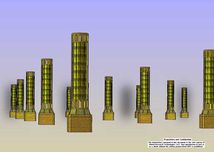CO2 Management (main)
From The Encyclopedia of Earth
(Redirected from Mitigation of global climate change)
CO2 Management
Biochar |
Air Capture |
Ocean Fertilization |
========
Recently Updated
 Seagrasses as carbon sink Last Updated on 2012-05-22 00:00:00 Research finds that the global carbon pool in seagrass beds is as much as 19.9 billion metric tons. They are vital to understanding climate change—they can store up to twice as much carbon as the world's temperate and tropical forests. Seagrasses Can Store as Much Carbon as Forests Seagrasses are a vital part of the solution to climate change and,per unit area, seagrass meadows can store up to twice as much carbon as the world's temperate and tropical forests. So report researchers publishing a paper in the journal Nature Geoscience. The paper, "Seagrass Ecosystems as a Globally Significant Carbon Stock," is the first global analysis of carbon stored in seagrasses. The results demonstrate that coastal seagrass beds store up to 83,000 metric tons of carbon per square kilometer, mostly in the soils beneath them. As a comparison, a typical... More »
Seagrasses as carbon sink Last Updated on 2012-05-22 00:00:00 Research finds that the global carbon pool in seagrass beds is as much as 19.9 billion metric tons. They are vital to understanding climate change—they can store up to twice as much carbon as the world's temperate and tropical forests. Seagrasses Can Store as Much Carbon as Forests Seagrasses are a vital part of the solution to climate change and,per unit area, seagrass meadows can store up to twice as much carbon as the world's temperate and tropical forests. So report researchers publishing a paper in the journal Nature Geoscience. The paper, "Seagrass Ecosystems as a Globally Significant Carbon Stock," is the first global analysis of carbon stored in seagrasses. The results demonstrate that coastal seagrass beds store up to 83,000 metric tons of carbon per square kilometer, mostly in the soils beneath them. As a comparison, a typical... More »  Pipelines for Carbon Dioxide Control in the United States Last Updated on 2011-09-10 00:00:00 Carbon capture and storage (CCS) is of great interest because potentially large amounts of carbon dioxide (CO2) emitted from the industrial burning of fossil fuels in the United States could be suitable for sequestration. Carbon capture technologies can potentially remove 80%-95% of CO2 emitted from an electric power plant or other industrial source. Power plants are the most likely initial candidates for CCS because they are predominantly large, single-point sources, and they contribute approximately one-third of U.S. CO2 emissions from fossil fuels. Note: This article contains information that was originally published in the Congressional Research Service reports Pipelines for Carbon Dioxide (CO2) Control: Network Needs and Cost Uncertainties (January 10, 2008) by Paul W. Parfomak and Peter Folger and Carbon Dioxide (CO2) Pipelines for CarbonSequestration:... More »
Pipelines for Carbon Dioxide Control in the United States Last Updated on 2011-09-10 00:00:00 Carbon capture and storage (CCS) is of great interest because potentially large amounts of carbon dioxide (CO2) emitted from the industrial burning of fossil fuels in the United States could be suitable for sequestration. Carbon capture technologies can potentially remove 80%-95% of CO2 emitted from an electric power plant or other industrial source. Power plants are the most likely initial candidates for CCS because they are predominantly large, single-point sources, and they contribute approximately one-third of U.S. CO2 emissions from fossil fuels. Note: This article contains information that was originally published in the Congressional Research Service reports Pipelines for Carbon Dioxide (CO2) Control: Network Needs and Cost Uncertainties (January 10, 2008) by Paul W. Parfomak and Peter Folger and Carbon Dioxide (CO2) Pipelines for CarbonSequestration:... More » 

